#monumental stonemason
Explore tagged Tumblr posts
Text
youtube
#Headstones Newcastle | Monumental #Stonemason #Newcastle - renovation, #restoration, inscription, #carving and #engraving
#headstones#newcastle#monumental stonemason#stonemason#gravestones#tombstones#monument#restoration#renovation#inscription#carving#engraving#sandblasting#Youtube
0 notes
Text
More (perhaps controversial) takes about the 141, this time asking what kind of artists they’d be (because I have a BFA and dammit I insist upon using it):
Soap’s tried a LOT of disciplines but always came back to painting. He’s an abstract expressionist and puts his whole body into his work; throwing paint across a monumental canvas, or moving pigment around with huge wedges he’s got to hold in both hands. His works are overwhelming, explosions of color and movement, so much happening in one place all at the same time that looking at them feels like looking at a bomb going off. (He’ll indulge in some figure drawing but mainly for fun with his hookups.) Think: Jackson Pollock.
Gaz is a portraitist with an uncanny ability to reveal his subjects’ personalities. He works almost exclusively in oils, in a style that blends academic painting with Impressionism, and spends days with his subjects, getting to know them on a level nearly as intimately as a lover, drawing them out of themselves into a state of honesty that’s both fragile and cathartic. Somehow he can translate the truth of a person onto canvas in a way that can be either comforting or brutal. Every piece of his manages to make the viewer wonder how he could know so many people so well. Think: John Singer Sargent.
Price is a stonemason and bronze sculptor. He works at a 1:1 scale and most often depicts figures in some sort of dramatic motion; dancing, flying, reaching into the distance, or with wind-tossed clothes or hair. The best way to describe his work is romantic, in the classical sense; he reveals moments of powerful emotion, uninhibited by propriety, such that his work feels like it could sweep you away. Price is an artist in love with something he hasn’t found yet. Think: Luo Li Rong.
Ghost works almost exclusively with metal. He learned to weld and never wanted to do anything else afterwords. His sculptures are constructed of raw, sometimes dangerous-looking pieces of steel, scraps he scavenges from construction sites himself and puts together with no plan other than to stop when it looks finished. His work is not always intimidating, though; sometimes, his favorite things to put together are weird-looking benches that he will deposit in unfriendly parks with nowhere to sit. He’s gotten fined more often than he remembers for it. Think: Julio Gonzáles.
#captain john price#simon ghost riley#kyle gaz garrick#john soap mactavish#mwritessoap#mwritesgaz#mwritesprice#mwritesghost#madi writes#deeply wanted to do the vaqueros#but also intended to compare them to American/european artists and considering that they’re Mexican I’m not sure it’s appropriate#need to brush up on Mexican art history!#controversial takes
293 notes
·
View notes
Text

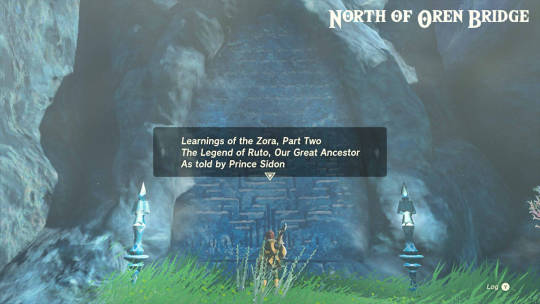
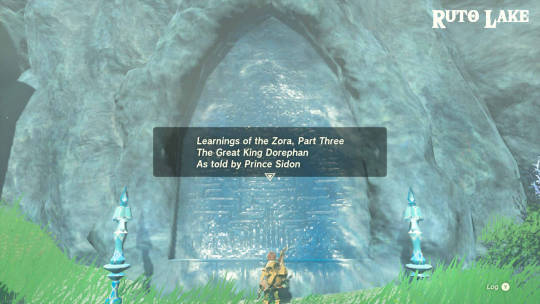
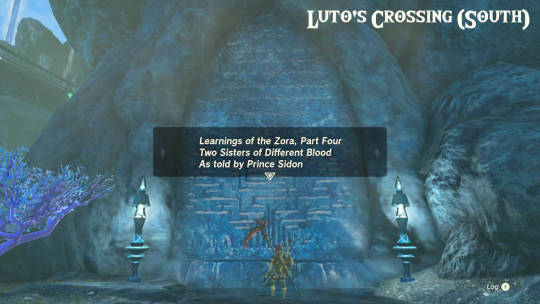
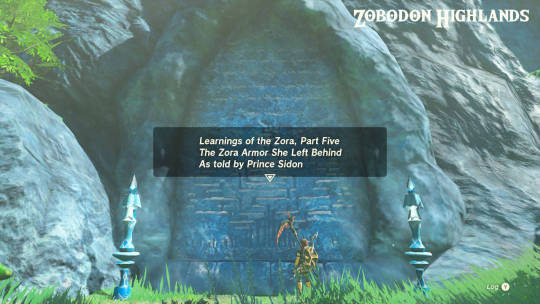
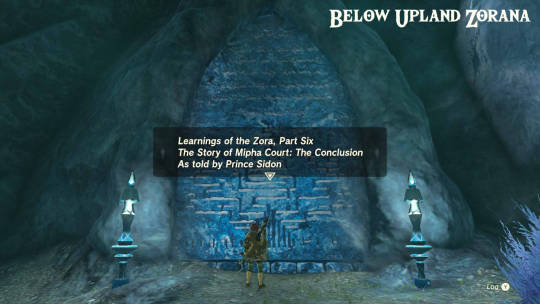
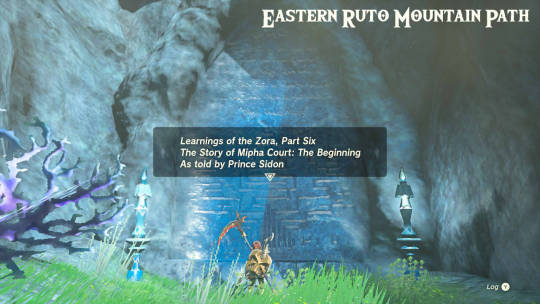
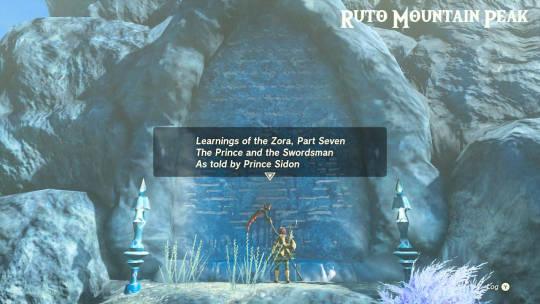
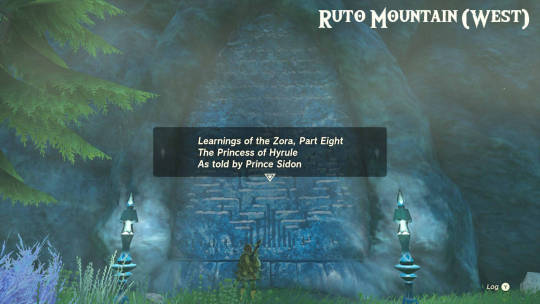
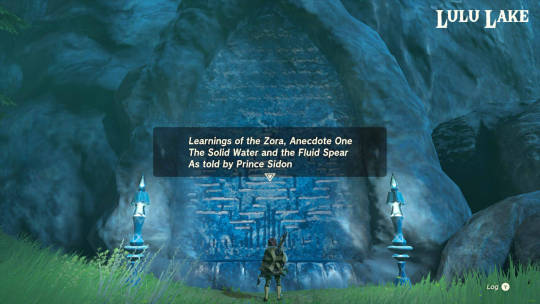
so in those [mumble mumble] years between BotW and TotK, the Zora replaced the weathered and unreadable monuments with new history writing by Sidon, and their contents have left me hmm emotionally compromised ??
i was gonna list em out in full but then i read them all and Sidon waffles so much bless him LOL
full transcripts below (+ the 11th monument in the Domain itself) expect Sidon being an adorable goof, Zora Deep Lore, waterbending, SO much gushing over Mipha and Link, Zelda being a sweetheart, and surprise Yona content !!!
just for clarity, i've highlighted the first word of each on-screen chunk of text ... i love Sidon so much but he's so verbose i kept missing the full log lol but im glad he went all in, its earnest, descriptive and poetic :') 💙 RIP the stonemasons ...
Learnings of the Zora, Part One The Waters of Zora's Domain As told by Prince Sidon
Long, long ago, right here in Lanayru, incredible transformations, both subtle and drastic in nature, shaped the land. The tall mountains birthed clouds, these clouds cried tears of rain, and this rain filled our deep valleys past the brim. In time, this overflowing water became the Zora River, which bred waterfalls that fell and nourished the vast Lanayru Wetlands. Perhaps it was inevitable that my Zora ancestors, who wandered in search of precious water, would finally settle here. The mountains of Lanayru are blessed with high-quality stone. The structures built from said stone are solid yet refined. Just like the Zora and our domain, our buildings exist in harmony with the water. It is a beautiful symbol of our way of life. If you go to the edge of the domain, close your eyes, and listen closely ... you shall be greeted by the gentle sound of water. This kind, soothing sound is a testament to the happy life the Zora are so grateful to have found here. As one born of royal Zora blood, my duty is as clear as it is unshakeable. I, Sidon, swear here and now ... I shall protect our home with my very life, that the gentle sound of water may never cease in our beloved domain.
Learnings of the Zora, Part Two The Legend of Ruto, Our Great Ancestor As told by Prince Sidon
It is written that long ago there was a strong-willed Zora princess who was as meandering as a winding river. This princess, who was dearly loved by her fellow Zora, was noble as she was innocent. Her name was Ruto. One day, a powerful and wicked man tried to take over Hyrule and brought great ruin to the once-peaceful Zora's Domain. Our tales speak of falled Zora soldiers drifting down the river as it sadly reflected the chaotic retreat of the terrified Zora. Princess Ruto bravely fought back her tears and she bore witness to the tragic misery unfolding in the domain. Even amid her heartbreak, the Zora princess did all she coult to help the weak and elderly escape. Next she swam against the river's current and climbed the mighty waterfall to challenge her foe. The details of this fight have fallen victim to the haze of time. Few details remain. Still, it is said she was aided by the princess of Hyrule and the hero of legend, and together they saved Hyrule. So the legend goes. I, Sidon, prince of the Zoram cannot help but ponder these events as I listen to the Zora children play in all their innocence. As Princess Ruta's descendant, it is my fate to carry the torch of her brave acts into tomorrow and beyond. I shall not fail.
Learnings of the Zora, Part Three The Great King Dorephan As told by Prince Sidon
Several springs after I lost my dear sister, Mipha, a large group of Lizalfos attacked the domain. It mattered not that this was my first true battle. The expectations of those around me weighed heavy on my shoulders. The absence of Mipha, who had always been there to encourage me with loving kindness, was like a spear to my heart. As for my own spear, though I was highly trained for its use, it seemed to only cut the air and slash the water's surface. I was taken off guard by a surprise attach from three Lizalfos hiding at the water's edge, each with their blade fixed on me. I knew that my time had come ... and that is when the three Lizalfos disappeared, as quickly as they had arrived. In their place, I saw the towering figure of my father, the great King Dorephan, who had just bested my foes with ease. "Sidon, my son," he said firmly. "You allwed your heart to falter. That is the quickest way to fall on the battlefield." His words cut deep, but as I stood on the brink of dispair, a familiar gently encouraged me. "Your king needs you." Many soldiers later attested they were certain they had also heard the sweet voice of Mipha on that day. From then on, my heart was true and my resolve firm. By lending strength to our king, we were able to save the domain.
Learnings of the Zora, Part Four Two Sisters of Different Blood As told by Prince Sidon
When I was young, I had an irrational fear of strangers. I was particularly bashful around Yona. Paralyzed, even. She was already so mature in manner, and she treated me like a little brother, even though we were not related. There came an unseasonably heavy rain that quickly flooded the river. Us children, who were playing there, were swept away. I was battered by the water's strong flow, my fins helpless to resist. It was Yona who dragged me to the safety of the shore. The water continued to swell as the shore waned, but Yona was unflappable, sweetly comforting me as I shivered in fear. It was Mipha, my dear sister, who finally showed up to rescue us with other Zora adults in tow. I still remember Yona's face as she gazed up at Mipha in admiration. My face must have looked the same as I gazed at Yona. As a child, I had two big sisters. One by birth and one by chance. Yona looked up to Mipha, and I was in awe of them both. Before I knew it, years had passed, and my feelings for Yona became more difficult to quantify. Then, one day ... My father informed me that the amazing young woman who had once been a like a sister to me was to be my bride. Perhaps these feelings and memories are too dear and private to commit to history, but such is the tale of this Zora prince.
Learnings of the Zora, Part Five The Zora Armor She Left Behind As told by Prince Sidon
For some time after I lost my beloved sister, even in the light shining on the water seemed dark and dreary to my eyes. But as they say, time heals all wounds, no matter how deep. I can now speak of her with a smile, as is only fitting. I shall now tell the tale of the Zora armor that my sister crafted for her future husband, as per our ancient custom. One dark day, the domain was in great peril, and I sought help from a traveling Hylian to save our home. He was sparing with his words, yet I trusted him at once. As fate would have it, he was a childhood friend of Mipha's. My father, King Dorephan, troubled by the domain's suffering, requested his help. The swordsman agreed without hesitation. Father bequeathed my sister's Zora armor to this courageous soul, along with her hopes for the safety of the domain. The armor fit Link perfectly - so perfectly that councilman Muzu, who then harbored a hatred of Hylians, could not object. My sister had already left this world, and with her went the dearly held intentions that she had instilled within that special armor. Yet, with Link's help, she shined a light on the Zora in our hour of need, reaching between worlds with gentle fingertips.
Learnings of the Zora, Part Six The Story of Mipha Court: The Beginning As told by Prince Sidon
There was once a terrifying monster on Ploymus Mountain, loosing shock arrows on all who dared to cross its path. It was of utmost importance to drive the beast away, but as the Zora are weak to electricity, our efforts were futile. That is when a lone Hylian arrived at the domain. This swordsman who was sparing with his words ... his name was Link. Unlike us Zora, he was immune to shocks! Well perhaps that is an exaggeration, but one thing is certain. He was very brave. After careful preparation, he ascended Ploymus Mountain and defeated the foul beast all by himself. As if in celebration of newfound peace, clean water mysteriously began flowing at the top of Ploymus Mountain. That is when many Zora, if not most, voiced support for building a place that all could enjoy in that formerly frightful spot. Yet the many tree roots and stones made this task tricky, leading to a focus on the no-less-difficult matter of the name. "Zora Park" was too obvious. "Ploymus Park" only conjured images of the former terrors found there. When I candidly asked whether we should focus on the hard work at hand rather than the name, they all turned my way. "Prince Sidon," they asked. "Surely you must have a good suggestion?" To that, I fell silent, and stayed so for a long while. I shall write the conclusion of this story on another monument.
Learnings of the Zora, Part Six The Story of Mipha Court: The Conclusion As told by Prince Sidon
The first half of this tale can be found on another stone monument. If it is not too much trouble, I advise reading that first. I now present the conclusion. When posed with the task of naming this storied location, I, Prince Sidon, fell silent. After a time, I timidly proposed the one and only name that came to mind for this place of newfound peace. I suggested that we name it after my beloved sister who had long been lost to us ... Mipha Court. I worried they would think I was unfairly favoring my own family's legacy by naming it after my kin. A hush fell over the group. After a time, one of the stonemasons raised his voice in agreement. More voices joined his, one after another. The idea was embraced whlly, and the craftsmen all returned to their work. Though the work was grueling, from then until the completion of Mipha Court, the air was filled with laughter and singing. This incident drove home to my very core how much everyone loved my sister. I hope one day to inspire such admiration. If there is ever to be a Sidon Court, I must work tirelessly to earn that honor.
Learnings of the Zora, Part Seven The Prince and the Swordsman As told by Prince Sidon
The rain always stops ... except when it does not. This humourous saying was once repeated with a soft chuckle around here. Then, one day, heavy rain started falling in the domain, and no matter how many days passed it did not cease. Although the Zora are a water-dwelling sort, we came to miss the warmth of the sun and dry winds upon our backs. Alas, as fervent as our desire was, we had no means of stopping the cause of this unprecedented disaster. When all had given up hope, I, Sidon, took it upon myself to invite a Hylian to the domain. This young swordsman of few words was named Link. I trusted him at once, sensing great devotion in his kind eyes. It was immediately clear that my instincts were correct. Thanks to Link, we were able to face the thread head on. Our battle with the source of the disaster was intense by my newfound friend and I refused to yield until we finally triumphed. Sometimes, writen words flow so much more readily than those spoken ... Link, my dearest friend, you are an unparalleled swordsman, and I admire you so very much. He may lack fins and gills, but it matters not. This hero among heroes exudes magnificence tempered with steadiness. Though we are different, our hearts both yearn to serve a higher calling. I learned much from him, and I am eternally grateful. As I recall my best friend, it occurs to me that though the rains have ceased, perhaps a true adventure never does.
Learnings of the Zora, Part Eight The Princess of Hyrule As told by Prince Sidon
One that despicable disaster had ceased to plague Zora's Domain, a distinguished yet humble lady paid us a visit. This young woman who appeared with Link at her side was none other than Princess Zelda of the royal family of Hyrule. "I beg forgiveness," she said earnestly. "Because of the royal family, Princess Mipha ..." She paused, unable to continue. Small, silent teardrops tumbled down her cheek and hit the floor, one after another, each saying a thousand unspaken words. She gently wiped her eyes and lifted her gaze to meet the king's, speaking kind words of gratitude for Mipha's sacrifice. We knew well that what had transpired was the result of a decision shared by the Zora and by Princess Mipha herself. There was no need for the princess of Hyrule's apology, and even less so for her sorrow. King Dorephan, along with the rest of the Zora, were moved by the depth of Princess Zelda's sincerity. She had held that unthinkable disaster at bay for nearly 100 years with nothing more than the sheer force of her own will. Yet she was not prideful. She dutifully set to work, traveling across Hyrule to secure cooperation for the kingdom's restoration. She was adored by all, yet so humble. She possessed an inner strength, but now I am not so certain. I feel a strong calling one day to acquire this same sort of strength within myself.
Learnings of the Zora, Anecdote One The Solid Water and the Fluid Spear As told by Prince Sidon
The Zora are not associated with water because of our dwelling place alone. We each also, to varying extents, possess the ability to actually manipulate water. We use this gift for many purposes. We use it to swim faster, to achieve mighty leaps from the waves below, to gather fish, and so much more. For me, the true awakening of this ability that many of my childhood chums already possessed came upon me quite suddenly. One day as I was training at Veiled Falls, the rain slickened my grasp, causing me to drop my spear. I reached to grab it, but it was already too far away. Soon it would fall to the bottom of the cliff, never to be seen again. I knew that I must take old of it, and at that moment, droplets created a stream extending from my outstretched hand. The water stream twisted and turned until it finally took hold of my falling spear and deftly returned it to my grasp. In that moment, the water was solid and my spear fluid. This sensation forever changed my approach to spearplay. I was reminded of how my sister, Mipha, described it ... and everything clicked. Water and spear became as one. Gaining yet another layer of admiration for my dear sister, I devoted myself to my spear training from then on.
Learnings of the Zora, Anecdote Two The Great Task Entrusted to Me As told by Prince Sidon
I, Sidon, was entrusted with the great task of renovating the Zora stone monuments that had fallen to ruin. There are 11 stone monuments total find in and around Zora's Domain, including the one you are now reading. The former text written by my father, King Dorephan, could not be salvaged, and so sadly it had to be replaced. Despite my royal blood, whispers abound that it is improper for someone my age to write over the king's glorious words. Ah, but do they not realize that it was King Dorephan himself who ordered me to undertake this restoration project? Father says it is not set in stone that I shall be the one to inherit the throne, as it is not a matter of blood alone. If we ask the eternal skies above whether I am fit to rule, they shall remain silent, and so we must look to our fellow Zora. He urged me to use these monuments to share my learnings and speak to our people straight from my heart. Father is older and wiser than I. His sage advice is a gift. As such, I have inscribed my thoughts upon these 11 stones. I do not know how far-reaching my words shall be, but it is my hope that they will reach whoever needs to hear them most. Until one of the descendants writes over my musings many years from now, I pray they resonate with whoever reads them.
WELL there we are, thanks for the history lesson Sidon you absolute sweetie fhjdkdjf i have thoughts and feelings and emotions but i wont make this post any longer than it already is but i love these characters byeeeEEE
#the legend of zelda#the legend of zelda: tears of the kingdom#tears of the kingdom#legend of zelda lore#loz totk#loz lore#totk lore#totk zora#totk spoilers#tears of the kingdom spoilers#zoras domain#prince sidon#totk sidon#zelda blogging#botw/totk blogging
171 notes
·
View notes
Photo

On this day, 21 April 1856, stonemasons in Melbourne, Australia, went on strike demanding a maximum eight-hour working day – down from 10 hours per day Monday-Friday with eight hours on Saturday. They marched from their construction site, the Old Quadrangle building at the University of Melbourne, brandishing a banner demanding “8 hours work, 8 hours recreation, 8 hours rest”. The workers were extremely well organised, and were soon successful in achieving their goal, with no loss of pay, for workers engaged in public works in the city. They celebrated on Monday 12 May, the Whit Monday holiday, with a parade of nearly 700 people from 19 trades. In 1903, workers in Ballarat, Victoria, erected an 8 hour day monument, commemorating the movement. More information, sources and map: https://stories.workingclasshistory.com/article/9337/Melbourne-8-hour-day-strike Pictured: The Melbourne eight-hour banner, 1856 https://www.facebook.com/photo.php?fbid=612378520935367&set=a.602588028581083&type=3
316 notes
·
View notes
Text
naruto dash simulator

🍂 comrademadara Follow
SANDAIME DOWN 🦀🦀🦀
🔥 shinobifurious Follow
reminder that sarutobi hiruzen was a WAR HERO who should be remembered as such :)
👘 yukata-yuri Follow
reminder that sarutobi hiruzen was a LITTLE BITCH and that we should all PISS on his GRAVE
4,501 notes

👅 trueartisanexplosion Follow
@tobi this sake isn't doing shit get ur ryō ready
👅 trueartisanexplosion Follow

i wnr himn to imroreganate mpe
63,399 notes

💜 rinnegone Follow
she village on my hidden until i leave
💜 rinnegone Follow
easy website
17,280 notes

🌊 7swordswag
93 notes

🍥 orangehokage Follow
save me instant cup ramen
🍥 orangehokage Follow
instant cup ramen
🍥 orangehokage Follow
instant cup ramen... save me..
7 notes

☀️ sandkaze Follow
regardless of any nepotism that may have been involved, I just think it’s messed up that they let a FOURTEEN YEAR OLD become kazekage. not to mention other villages could take it as a sign of weakness that the most powerful shinobi we have is so young
🦝 goatedgaara Follow
idk wasn’t the yodaime mizukage really young?
⚡️ codenamekage Follow
lol you’re clearly new to kageblr. that rumors been debunked for ages, the guy was just super short
kuna1-deactivated
feels like they’re just letting anyone be a kage these days. how could tsunade be the best choice for hokage when jiraiya is clearly superior in strength 🙄
🌸 blossom-princess Follow
12 Butsuma Senju Ave, Konohagakure, LOF 118211
[This post went to heaven.]

🐸 jiraiya-updates Follow
Update on the cease and desist order from Konoha:
This blog will be deleted in 48 hours. We never considered the harm our hyperfixation could have on Konoha's national security, and for that we are sincerely sorry, both to Jiraiya and the residents of Konoha. For those wonderful people who have expressed concern for the mod team, the legal case is still ongoing but right now it's looking like a fine.
More information on the case, the ANBU incident and the situation with @orochimarupdates can be found below the cut.
Keep Reading
1,622 notes

🎎 fyeahhistory Follow

The Valley of the End
These statues were constructed by artist and stonemason Hikaru Aburame in 1737 KY. Commissioned by the Shodaime Hokage Hashirama Senju, the statues depict Senju and his longtime ally and rival Madara Uchiha. Uchiha and Senju were responsible for the Uchiha-Senju Alliance which founded the Hidden Leaf Village and put an end to the Warring States period. The monument, which potrays the two opposite each other forming the confrontation sign, was constructed in the valley where Uchiha lost his life to Senju during their battle a year prior.
Photo taken by Ami Sugiyama
6,410 notes
34 notes
·
View notes
Text
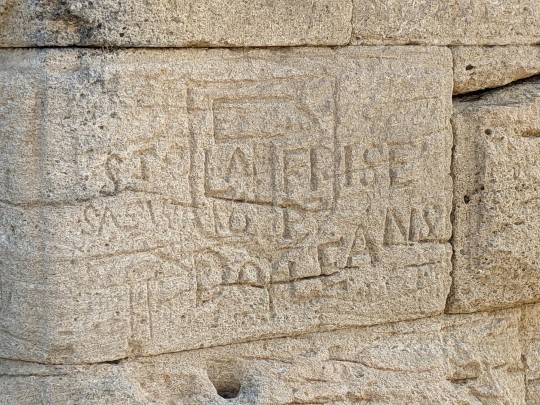




Graffiti by journeyman stonemasons, Pont du Gard
From the museum:
"As of the 17th century, the journeymen of the Tour de France* considered the Pont du Gard a marvel of stone architecture. They paid homage to this great "Antiquity" by leaving their marks and their tool's form engraved in the stone ... A total of 320 [jouneymen's] marks have been identified on the Pont du Gard, from the lower piers up to the third- story canal paving stones. Workers engraved these marks after they had worked on the edifice or simply to indicate that they had been to the site. The oldest mark dates to 1611, and the most recent dates to 1989. Half of these are the signatures of journeymen stonecutters and can be explained by the fact that this is an architectural monument entirely dedicated to stone ... These graffiti contribute in some way to the history of the monument."
If you look closely at all of these you can identify the tools of the trade carved in along with the names: all of these images depict hammers & many depict a level and a compass crossed to form a sort of diamond or X shape
*a jouneyman's fraternity of medieval origin. unrelated to the bicycle race
#photos by me so they're just random ones I could see not necessarily the best ones#but I LOVE how they all have the tools depicted too#thoughts#fullones ululamque cano
61 notes
·
View notes
Text



7th April 1767 saw the birth in Torphichen of Henry Bell.
Not a well known name to many but Bell would make his name by building the the paddle steamer PS Comet and, in 1812, using it to run Europe’s first commercially viable passenger steamboat service on the River Clyde.
Bell was educated in the local Parish school at Torphichen his family were well known at the time as millwrights, builders and engineers.
After schooling he spent time learning trades as a stonemason, Millwright and Model ship modeler, he was something of a visionary and a jack of all trades, it was another trade, engineering that he ended up excelling.
He became fascinated by the then experimental technology and potential of steam propelled ships. He corresponded with and may have assisted the American steamship pioneer Robert Fulton who, in 1807, introduced a steamboat service in New York. However, Bell failed to persuade the Admiralty to take any interest in his ideas about steam propulsion. While continuing to experiment and speculate, he and his wife moved in 1807 to Helensburgh where they ran an inn and superintended the public baths.
He must have been bored for as well as doing the two jobs in Helensburgh Henry was still tinkering with his steam engines, and he commissioned a Port Glasgow shipbuilder to build a 30-ton wooden paddle steamer with a 3hp engine. He named her Comet after a spectacular comet that had appeared the previous year. In August 1812, after a trial voyage from Port Glasgow to the Broomielaw and then back down to Greenock, during which the boat made 5 knots against a headwind and dramatically cut the usual journey time, Bell inaugurated a regular passenger service between Glasgow, Greenock and Helensburgh. No longer did ferries need to be so dependent upon wind and tide. This was the first commercial steam passenger service in Europe.
Lengthened and improved, the Comet then ran a service to Oban and Fort William via the Crinan Canal, but in 1820 she was shipwrecked off Oban. A successor Comet sank after a collision with considerable loss of life. Bell’s pioneering venture was soon superseded technically and eclipsed by rivals but he had shown the way.
Bell was not a successful businessman and ended his days in poverty, dependent upon a public subscription on his behalf, supported by Thomas Telford among others, and an annual stipend from the trustees of the Clyde Navigation.
He died in aged 62 and is buried in Rhu Kirkyard at Gare Loch, Argyll and Bute, a grand statue of him marks his tomb, there is also a monument to Henry Bell on the Clyde at Helensburgh.
9 notes
·
View notes
Text
So, I've written my first Heartstopper fic....
(and, of course, it is sad)
hic jacet (230 words) by AfroGeekGoddess (registered users only)
Chapters: 1/1
Fandom: Heartstopper (Webcomic), Heartstopper (TV)
Rating: Teen And Up Audiences
Warnings: Major Character Death
Relationships: Nicholas "Nick" Nelson/Charles "Charlie" Spring Characters: Charles "Charlie" Spring (Heartstopper), Nicholas "Nick" Nelson, Original Female Character(s), Original Characters
Additional Tags: Headstones - Freeform, gravestones, Cemetery, Implied/Referenced Character Death, stone carving, Aged-Up Character(s), Old Married Couple, Grief/Mourning, Marriage, Canon Queer Character, Canon Gay Character, Canon Bisexual Character, Canon Queer Relationship, Sculpture, Epitaph, POV Original Character, POV Outsider, Death from Old Age, Podfic Welcome, One Shot, Monumental masonry, Stonemason, Latin
Summary: “After all these years, she still carves gravestones by hand.” Nick and Charlie, viewed from an unusual perspective.
6 notes
·
View notes
Photo

The Mysterious Coral Castle
The extraordinary Coral Castle, located in the suburbs of Homestead, Florida, is made entirely of oolite limestone, and one man single-handedly built it. Ed Leedskalnin, a Latvian immigrant, pursued his project as a dedication to his long-lost love. The massive work took place over the course of 28 years, and it still stands today as an ode to love imbued with mystery.
Back in the 1900s, Leedskalnin had been engaged to his love Agnes Skuvst, to whom he referred to affectionately as his “Sweet Sixteen.” Agnes broke off the engagement one day before the wedding ceremony, and fraught with pain, the broken-hearted Leedskalnin decided to move to North America and create a monument in remembrance of his love.
He first began the project of the Coral Castle (originally called the Rock Gate Park) in Florida City. However, Leedskalnin purchased 10 acres of land in Homestead and decided to relocate the great structure there.
The sculptural garden surrounded by a coral gate features a geomantic landscape—a moon pond representing the phases of the moon, a sundial that accurately tells time, and a towering telescope aligned to the North Star. The structure also includes a giant coral rock table shaped like a heart, an ode to his valentine Agnes.
Nevertheless, how the remarkable work was built remains an enigma. Leedskalnin never divulged how he was able to lift and position the gigantic stones. Residents had noticed the trucks carrying the coral rocks along the South Dixie Highway, but no one ever saw how Leedskalnin was able to unload them. To protect his privacy during construction, he was very particular about working at night—to avoid any detection—and even went on to build “lookouts” along the castle’s walls.
Though he came from a family of stonemasons, his methods have stumped engineers who have compared his techniques to that of the amazing Stonehenge. Some of the stones are even calibrated according to celestial alignments, and the stone walls fit seamlessly together without the use of materials like cement. Leedskalnin once claimed that he discovered not only how the ancient builders in Peru and Egypt were able to set in place blocks of stones with only primitive tools but also the secrets of anti-gravity.
He wrote a series of pamphlets on magnetism, one titled Magnetic Current (available at the Coral Castle gift shop).
Numerous rumors have attempted to explain the seemingly miraculous techniques used by Leedskalnin, from magnetism to magic, but the methods used by this eccentric stonemason to create his fortress are a secret he took to his grave.
124 notes
·
View notes
Note

Let's have some Elden Ring fun.
Make up this weapons name and lore and I will let ya know how close ya got.
The stonemason clever: part of a tower made by a well known stone mason that was ripped out by a creature sculpted to protect the monument reconfigured into a beautiful yet brutal weapon
4 notes
·
View notes
Text
youtube
0 notes
Text

The Mysterious Coral Castle
The extraordinary Coral Castle, located in the suburbs of Homestead, Florida, is made entirely of oolite limestone, and one man single-handedly built it. Ed Leedskalnin, a Latvian immigrant, pursued his project as a dedication to his long-lost love. The massive work took place over the course of 28 years, and it still stands today as an ode to love imbued with mystery.
Back in the 1900s, Leedskalnin had been engaged to his love Agnes Skuvst, to whom he referred to affectionately as his “Sweet Sixteen.” Agnes broke off the engagement one day before the wedding ceremony, and fraught with pain, the broken-hearted Leedskalnin decided to move to North America and create a monument in remembrance of his love.
He first began the project of the Coral Castle (originally called the Rock Gate Park) in Florida City. However, Leedskalnin purchased 10 acres of land in Homestead and decided to relocate the great structure there.
The sculptural garden surrounded by a coral gate features a geomantic landscape—a moon pond representing the phases of the moon, a sundial that accurately tells time, and a towering telescope aligned to the North Star. The structure also includes a giant coral rock table shaped like a heart, an ode to his valentine Agnes.
Nevertheless, how the remarkable work was built remains an enigma. Leedskalnin never divulged how he was able to lift and position the gigantic stones. Residents had noticed the trucks carrying the coral rocks along the South Dixie Highway, but no one ever saw how Leedskalnin was able to unload them. To protect his privacy during construction, he was very particular about working at night—to avoid any detection—and even went on to build “lookouts” along the castle’s walls.
Though he came from a family of stonemasons, his methods have stumped engineers who have compared his techniques to that of the amazing Stonehenge. Some of the stones are even calibrated according to celestial alignments, and the stone walls fit seamlessly together without the use of materials like cement. Leedskalnin once claimed that he discovered not only how the ancient builders in Peru and Egypt were able to set in place blocks of stones with only primitive tools but also the secrets of anti-gravity.
He wrote a series of pamphlets on magnetism, one titled Magnetic Current (available at the Coral Castle gift shop).
Numerous rumors have attempted to explain the seemingly miraculous techniques used by Leedskalnin, from magnetism to magic, but the methods used by this eccentric stonemason to create his fortress are a secret he took to his grave.
13 notes
·
View notes
Text
A Talian Tale: The Witch of Montemurato
The following short story written by Mary Hoffman is from the official Stravaganza-website, which doesn't exist anymore. It is accessible through the Wayback Machine, but I am uploading the short stories here to a) act as a secondary archive and b) to make them accessible to fans. If this story is ever re-published somewhere or I am asked to delete it, I will do so. This post will be unrebloggable, but feel free to link to it if you wish to add comments/discuss the story. I do not own the story, and it is directly copy-pasted from the old website.
---
In City of Masks chapter thirteen, Rodolfo Rossi, the Stravagante of Bellezza, refers to a story told in Montemurato of a witch who put a curse on the walled city some hundred years before (i.e. around 1450). This is that story.
A long time ago the city of Montemurato was plagued by the tricks of a witch named Selvaggia. She lived at first in a poor hut outside the walls, having settled there after a life of drifting. She was not very good at her calling but she was very lazy and completely ruthless, which served just as well.
She gave out that she was adept at putting the “evil eye” on beasts and people and then she let threats and rumour do the rest.
“If you don’t give me a fresh egg every day, none of your chickens will lay,” she would say to one farmer. “A pail of milk or the whole herd of cows will dry up,” to another. To a hunter, “You’ll catch nothing if you don’t give me something for the pot twice a week.”
Well, whether it was because the farmers and the hunter became nervous, or because a few of Selvaggia’s spells did work, in their haphazard way, word got around that it was unwise to cross the witch of Montemurato and she began to grow rich.
A house of stone was built for her (“None of the other houses you build will stay up if you don’t,” she had threatened the stonemasons.) She had a well and a pig and chickens of her own and, thanks to her awful warnings to weavers and spinners, Selvaggia had linen on her bed, warm clothes in her chest and hangings at her windows. Her larder was well stocked with cheeses and apples and olives and smoked meats. Every morning a fresh loaf was left on her door stone. Selvaggia was actually taking a tithe from every working man and woman in the region, without doing a stroke of work.
But Selvaggia was not the only witch in the city. There was another, called Maga Margherita, who had little to boast of, save her skills and the provisions she earned by exercising them. Maga Margherita lived in a small wooden house of two rooms and made her living by tending citizens’ ailments with her decoctions of herbs and roots. There wasn’t a sore throat or a teething child or a birthing mother or an ailing granny in Montemurato that hadn’t been soothed by a visit and a potion or lotion from Maga Margherita.
Even in the Prince’s palace her usefulness was known and appreciated. When the Princess was brought to birth of her first child, she had a hard time of it and the midwife suggested sending for Maga Margherita. The old woman had worked with the young witch before and knew how calming her presence and her infusions were at a childbed. The Prince sent his own bodyservant to fetch the witch and she came straightaway.
Perhaps it was Maga Margherita’s presence that saved the baby princess, but it was too late to do anything for her mother but bathe her forehead and close her eyes when the time came. Which it did soon, just after she had said, “Call her Florabella and take care of her for me.” She seemed to look as much at Maga Margherita as at the Prince when she lay down her burden and departed this life.
The Prince grieved for his wife and hired a wet-nurse for his daughter. He built a marble monument in the palace grounds for the dead princess and a stone cottage inside the city walls for Maga Margherita. He asked the witch to take a part in the upbringing of little Florabella and she was glad to oblige.
Princess Florabella of Montemurato grew up knowing she was loved. Her father was a sad grave man except when he was with his child and she loved to make him smile. Everyone in the palace wanted to spend time with the laughing, rosy child with the brown curls. But her special favourite was Maga Margherita, who came regularly to the palace to tell her stories.
At first, when Florabella was a babe-in-arms, the witch's stories were very simple — no more than little songs or rhymes or teaching her the names of her toes. But as the princess grew older, so Maga Margherita told her more and more of the legends and beliefs of Talia, as well as teaching her the skills she knew of herblore and spellcraft. There were some in the city who were uneasy about this, since the child was a baptised member of the church. But no-one in the palace doubted the good influence of the witch and the princess thrived.
Many years passed, sixteen in fact, and during this time the two witches' paths never crossed. Selvaggia continued to flourish on her ill-gotten gains and rarely had to exert herself to cast a spell or throw the evil eye on anything or anyone. Maga Margherita went about her daily work and took care to discharge the wish of the dying princess.
But gradually the lives of the people of Montemurato fell under strain. There was a bad summer, when heavy rain destroyed most of the crops, followed by a murrain which carried off many of the animals. Food was scarce and families had to draw their belts tighter. At such a time, it was harder to give Selvaggia her dues and yet they believed they could not afford not to, lest she wreak a terrible revenge on them.
As people's lives got harder, Selvaggia became more demanding. She wanted a bigger house, finer linen, more food in her larder. And such was her power over the local people, that she got her way. And that made her even worse. She made up her mind that she must have her own personal maidservant.
Over the years, several young women had worked for a while in Selvaggia's house, sweeping her floors, washing her linen and cooking her food. But they never stayed for long, so cross and demanding was their mistress. And of course she didn't pay them a single scudo.
But Selvaggia did not want just any girl. No, Selvaggia wanted the best-loved young woman in the city. And if she didn't get her, then all the young women would lose their looks and Selvaggia would ensure that they never married or bore children.
The news spread fast through the city. No-one was prepared to send their own beloved daughter yet no-one wanted to risk her future happiness either. It was not long before word reached even to the palace. Princess Florabella, who had grown into a pretty and kind-hearted young woman, immediately volunteered herself.
"What?" raged the Prince. "Go and live with a bad witch for the rest of your life? Out of the question. I couldn't live without you."
"It won’t be for the rest of my life, Papa," said Florabella. "I shall think of a way to make the witch take back her threats."
"What do you think, Margherita?" asked the Prince, who had become very reliant on her judgment.
"I think it is just like Florabella, Your Highness," said Maga Margherita. "You should trust her."
And so it was that Florabella walked out of the palace where she had spent the last sixteen years, wearing her simplest dress and taking a very small bundle.
It was an adventure. Word spread among the citizens of Montemurato about where she was bound. So that by the time she reached Selvaggia’s imposing stone house, Florabella had quite a crowd at her heels. The door flew open of its own accord — a cheap trick which Selvaggia could manage quite easily — and Florabella stepped boldly inside.
For the next three weeks she swept and cleaned and washed and cooked and at first she didn’t mind it too much. It had the charm of novelty, for the princess had never done any of these things before. But after a while she got tired of the work, not so much because it was hard and dull drudgery, but because Selvaggia was never satisfied with what Florabella had done.
“My egg yolk wasn’t runny this morning,” the witch would say. “And my toast was burnt,” quite forgetting that she herself had called the princess away from her breakfast-making to brush her hair.
Florabella decided it was time to pit her wits against her mistress. She had studied the witch carefully and realised that she was not as all-powerful as the citizens of Montemurato believed. She was lazy and greedy and very ambitious. Nothing was ever enough for her. She had been very interested to discover that her new servant was the Prince’s daughter and quizzed her hard about her father.
“He can’t be long for this world,” she said. “Not at his age and with all the grief he has suffered. And when he goes, who is to take over the throne of Montemurato? Not a chit of a girl like you, surely?”
Selvaggia asked Florabella many questions about the palace — how many rooms it had, what number of chandeliers and staircases and mantels — and a plan began to grow in the princess’s mind.
So on a day when Selvaggia was just a tiny bit less grumpy than usual and had even said that the cup of chocolate Florabella had brought her was “not unpleasant”, the princess proposed a wager. They would have a test of wits, each to ask the other three riddles. The winner would have the throne of Montemurato. But if Florabella won, then Selvaggia must leave the city for ever.
The witch agreed, confident that she knew more than the princess. Her first riddle was:
“What shines by day and by night?
“Easy!” said the princess. “The answer is silver. My turn now. What has eyes behind its back?”
“Haha!” cackled Selvaggia. “A peacock! Now, what takes one in three?”
Florabella thought for a bit. It might have been childbirth, but in the end, she got the answer.
“The plague,” said Florabella. “Now answer me this one. What covered a beauty without concealing her?”
Selvaggia had a hard time thinking of the answer to that one. Then she suddenly remembered some gossip that had reached Montemurato from Bellezza.
“The glass mask, the glass mask!” she cried, capering up and down. “It broke and marred the Duchessa’s beauty.” Selvaggia was beginning to enjoy herself. “Now answer me this: where do twelve giants guard a treasure?”
Florabella pretended to think but she didn’t really need to; she had known this story since her babyhood. But she answered slowly.
“This city of Montemurato. The giants are the twelve towers in the walls. The story says they were once real giants, turned to stone by time and the treasure they guard is our precious city itself.”
Selvaggia was seriously annoyed. The princess had answered all her three riddles so that there was no chance of the witch winning the city’s throne, at least not if she played fair. But Florabella hadn’t won yet; Selvaggia had one more question to answer.
“Tell me,” said the princess, “How does one get rid of a witch?”
Selvaggia’s eyes started out of her head. She raged, she cursed, she tried to hit Florabella with a broom. But there was no way out of the knot that the princess had tied for her. If she answered the question correctly, Florabella would know how to get rid of her. If she answered it incorrectly, she would have lost the game and have to leave anyway. Doubtless a cleverer witch could have lied or cheated herself out of the predicament, but Selvaggia couldn’t.
She snatched up her broomstick and flew out of the house in a rage. But she had enough wit left to produce one last spell. It was a very hot day in late August, the summer as fine this year as it had been wet the year before. As Selvaggia flew over the city, she sparked off a hundred small fires which smouldered in wooden roof beams and dry thatch.
“May the city burn till this witch is consumed!” she screamed her parting curse, knowing she was well out of reach of the flames, as she flew far away through the blue sky till her broomstick was a black speck like a crow in the distance.
Florabella heard the curse as she hurried back to the palace, through streets where anxious citizens formed bucket chains to put the fires out.
At the palace, Maga Margherita and the Prince were organising their own bucket-chain down to the small lake in the grounds.
“My darling!” said the Prince, dropping his bucket and clasping Florabella in his arms. “You’re back! But what has happened?”
“We saw Selvaggia fly over the city and then the fires began,” said Margherita.
Quickly Florabella told them everything, including Selvaggia's last words.
Maga Margherita stopped what she was doing. “We are going about this the wrong way,” she said. “We must build our own fire, not put this one out.”
She summoned all the servants to pile up brushwood in the palace courtyard. They thought she was mad. “Do as she says,” ordered the Prince. Maga Margherita took an old gown of hers and stuffed it with straw. She gave it a hat and murmured a spell over it. It began to take on a look of Selvaggia. By then the bonfire in the courtyard was built. The Prince threw the effigy of the witch on it and Maga Margherita set light to it.
The dry wood caught and crackled and before long there was a hearty blaze. The palace gates were thrown open and the people streamed in to see what madness had prompted their Prince to light a bonfire when his city was in danger of burning down. They stood round the bonfire sweating in its heat. When the flames reached the straw-filled witch, a silence fell over Montemurato.
The witch effigy burned to a crisp and a great shout went up from the courtyard. Every flame in the walled city flickered and went out, apart from the bonfire. The witch had been consumed and the city was saved.
What rejoicing was there that night! No longer did the hard-working people of Montemurato have to share the fruit of their labours with the witch. An innkeeper who was famous for the strong liqueur he served, a thick yellow liquid formerly known simply as “the Drink”, re-named it “Strega”, the witch. And his customers that night vied with one another to see how quickly and thoroughly they could “consume the witch”.
As for the Prince, he married Maga Margherita and did not die for a long time. When he did, Florabella became ruler of the city and she and later her husband and children, lived in harmony with her stepmother for the rest of her days.
Nothing was ever heard of Selvaggia again but the people of Montemurato burn her in effigy every year at the Festa della Strega in August to this day. And they “consume the witch” in every bar and tavern of the city.
Note: My apologies to the good people of Naples, who in Italy created the powerful drink called “Strega”. The equivalent city-state in Talia, known as Cittanuova, had nothing to do with the invention of this favourite tipple of Enrico the spy.
Copyright © Mary Hoffman 2002
4 notes
·
View notes
Text
Europa Nostra - Most Endangered in 2023
On the occasion of the 10th anniversary of the 7 Most Endangered Programme in 2023, Europa Nostra – the European Voice of Civil Society Committed to Cultural and Natural Heritage – and the European Investment Bank Institute have just announced the 11 most threatened heritage sites in Europe shortlisted for this year’s edition of the programme.

Among 11 most endangered monuments and heritage sites in Europe for 2023 are Kortrijk Railway Station (Belgium), Domain and Royal Museum of Mariemont in Moralwez (Belgium), Tchakcinij Fortress in Zugdidi (Georgia), Sister's House Ensemble - former Moravian settlement in Kleinwelka (Germany), Mansion Konaki of Gidas in Alexandria (Greece), Herman Otto Museum in Miskolc (Hungary), Memento Park in Budapest (Hungary), Cultural Landscape of Paštrovska Gora (Montenegro), Cultural Landscape of Sveti Štefan in Paštroviči (Montenegro), Watermills of Bistrica in Petrovac na Mlavi (Serbia), and the Partisan Memorial Cemetery in Mostar (Bosnia and Herzegovina) designed by Bogdan Bogdanović.
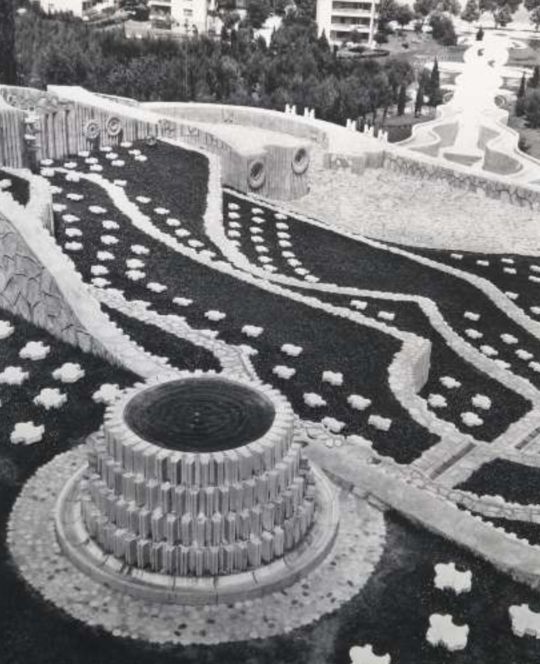
A view from the top of the cemetery before the latest conflicts.
The selection was made on the basis of the outstanding heritage significance and cultural value of each of the sites as well as on the basis of the serious danger that they are facing today. The level of engagement of local communities and the commitment of public and private stakeholders to saving these sites were considered as crucial added values. Another selection criterion was the potential of these sites to act as a catalyst for sustainable development and as a tool for promoting peace and dialogue within their localities and wider regions.

A view on the central fountain at the top of the site.

A sketch showing the path of the water flow.
The 11 endangered heritage sites were shortlisted by an international Advisory Panel, comprising experts in history, archaeology, architecture, conservation, project analysis and finance. Nominations for the 7 Most Endangered Programme 2023 were submitted by member organisations, associate organisations or individual members of Europa Nostra from all over Europe as well as by members of the European Heritage Alliance. For the Partisan Monument in Mostar a support was given among others also by Architectuul and DESSA Gallery from Ljubljana.

A cross-section of the cemetery and its terraces.
The Partisan Memorial Cemetery was built in 1965 in the town of Mostar. It is one of the largest anti-fascist monuments and sites in the Balkans, with its 300-metre-long paved ceremonial pathway rising more than 20 metres up a hill. The cemetery, which features some 700 individual tombstones as grave markers of freedom fighters from the Yugoslav Partisan movement, is part of a series of monuments and sites built in the region in memory of the partisans who died during World War II.
It was designed by the famous Yugoslav architect Professor Bogdan Bogdanović from Belgrade. Skilled stonemasons built the monument over several years, using over 12,000 carved limestone pieces, rubble from the town’s destruction during the war, and traditional stone roof tiles recycled from Mostar houses. The monument was inaugurated in 1965 by the President of Yugoslavia, Josip Broz Tito, on the occasion of the 20th anniversary of the liberation of Mostar from the Nazis and their local allies in 1945.
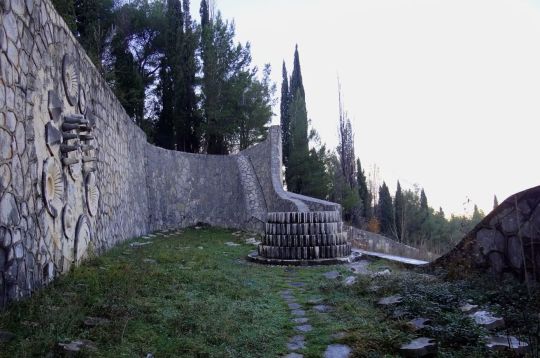
In front of the portal lies an a-centrically located gear-shaped fountain which used to develop a water stream that flowed down the terraces and emerged again in the dead end space at the bottom of the complex.
The Partisan Memorial Cemetery – with its memorial significance and relevance – has become a target for destruction, both in times of war and in times of peace. Although much damaged during the war in 1992-1995, the Partisan Memorial Cemetery suffered further damage in the period following the war. It is important to add that after the violent disintegration of Yugoslavia, many memorial sites built after World War II were neglected or even abandoned in the wider region, including the Partisan Memorial Cemetery in Mostar.
After the war, the first conservation and restoration works on the Partisan Memorial Cemetery were done in 2005 with the support of donor funds from the Government of The Netherlands and the Kingdom of Norway, and with co-financing from the City of Mostar and Federation of Bosnia and Herzegovina.
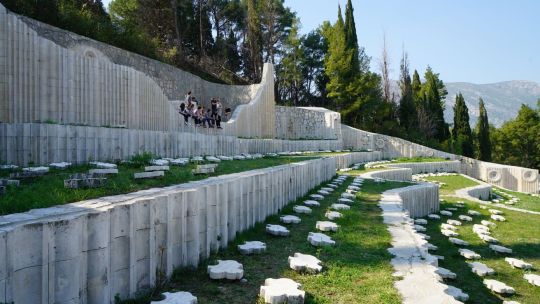
The complex is a necropolis, 630 abstractly shaped stone markers testify the multiethnic army that fought together and is buried here with names belonging to Serbs, Croats, Bosniaks, Jews.
However, the Partisan Memorial Cemetery has been, and still is, one of the region’s contested heritage sites. This has resulted in repeated acts of vandalism up until the most recent destruction which happened in June of 2022. This was followed by numerous reactions from the Mayor, the City Council, the Commission to preserve national monuments of Bosnia and Herzegovina, as well as from anti-fascist activists and associations both at local and international level, and also the reaction from numerous organisations from the territory of former Yugoslavia, which condemned the vandalism of the Partisan Memorial Cemetery. Recently, the Agency “Old City” of the City of Mostar launched the public procurement for the revitalisation, rehabilitation and illumination of the Partisan Memorial Cemetery. However, the monument does not yet have a holistic plan for its conservation and maintenance with a corresponding funding. The whole process of its necessary restoration and revitalisation therefore remains precarious.
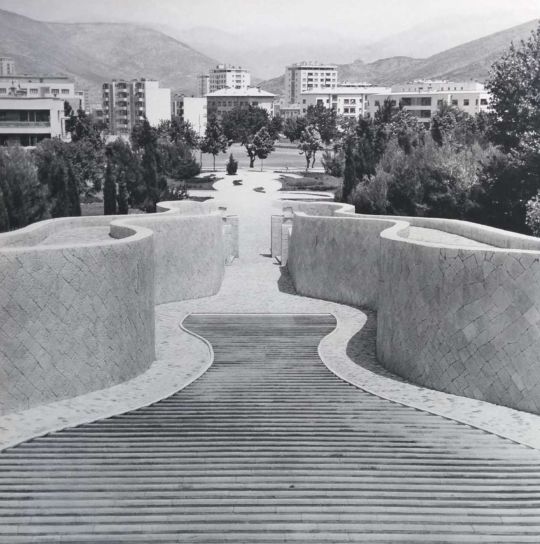
The partisan cemetery in Mostar is an integral part of the city and can be easily considered as an urban place.
The local community in Mostar has developed various campaigns for the legal protection of the Partisan Memorial Cemetery as a Monument of National Importance. Among other initiatives, they produced a documentary about the history of this memorial site and the threats and challenges it faces today.
The nomination of the cemetery to the 7 Most Endangered Programme 2023 was made by IDEAA Mostar with the endorsement of the Mayor of Mostar, the Galerija DESSA, Arcihtectuul and Europa Nostra Serbia. The nominator advocates for adequate legal protection of the Partisan Memorial Cemetery following its designation as a Monument of National Importance back in January 2006, for the European and international recognition of its outstanding historical and artistic values, as well as for the development of a sustainable rehabilitation, maintenance and management plan for this exceptional memorial site and the allocation of necessary funds – from local, national and European sources – for the quality implementation of such a comprehensive plan.
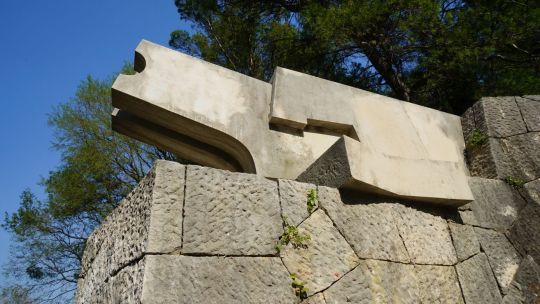
An abstract lion sculpture at the entrance of the complex.
The Advisory Panel of the 7 Most Endangered Programme commented: “The original design of the Partisan Memorial Cemetery in Mostar deliberately avoids the use of political or religious symbolism but makes use of cosmological symbols reminiscent of pre-Columbian remains and perhaps also referencing similar elements present in medieval sites in Bosnia and Herzegovina. As such, it is an outstanding example of the high-quality commemorative culture rooted in anti-fascist ideals within SFR Yugoslavia. At the time when Europe seeks to assert and put a much stronger emphasis on the vital importance of the shared values which form the very basis of the entire European project, this significant place of memory located in the Western Balkans should be restored with the support of local, national and European funds and protected for present and future generations.”

On Wednesday, June 15, 2022, vandals carefully and cold-bloodedly destroyed all the commemorative plaques.
The Executive President of Europa Nostra, Prof. Dr. Hermann Parzinger, stated: “This shortlist covers a wide variety of monuments and heritage sites which are facing different types of serious threats. The local communities and civil society organisations are deeply committed to preserving these remarkable examples of our shared heritage, but they need broader support. We therefore call on local, regional, national and European stakeholders, both public and private, to join forces with Europa Nostra and our network of members and partners to secure a viable future for these shortlisted sites.”

The "cosmic portal" is centrally located on the wall that backs the uppermost terrace. This circular element seems to act as a door between the two worlds and tries to reconcile the different visions that various religions have developed about the afterlife.
The final list of 7 Most Endangered heritage sites in Europe for 2023 will be unveiled in April.
21 notes
·
View notes
Text
Let me introduce you to my minecraft world!

Under the cut because you can’t put images side-by-side in a regular post


This is Port Historia, where I live. A small, once-barren island, its main export is bamboo, but it’s filled to the brim with cartographers and librarians. It’s only a short boat ride away from some fascinating things like mushroom islands, ocean monuments, and other things of historical importance, which is where it gets its name.


This is Shattered Peak (Hidden Valley). It once sat at the top of a cliff, but a landslide devestated the village and sent it tumbling towards the river. The river clay and neighboring fields mean its main export is pottery, terracotta, and brightly colored woven things-- they are a village of crafts and colors. It is also the agreed-upon middleground where all the villages meet in a festival every five years!


These are the Twin Cities. Two massive, thriving towns that expanded into eachother until they were nearly indistinguishable. The land ripped open between them-- either due to an earthquake, or perhaps a curse... but they still consider themselves part of the same. Due to their size as a bustling city, they have professions of every type!


This is Redwind Cliff, a windswept town on the top of the a sheer cliff face. Their main export is wheat and meat, as the plateu they live upon ensures the animals never stray, and it is known for its beauty. They are the closest to the map’s edge aside from Summer’s Valley, and pride themselves in their work.




This is Summer’s Valley, a former mining town, and the village at the farthest corner of the map. Once, it was home to some of the most skilled metalworkers and stonemasons in the entire land. But they sealed off their mines, for what lies beneath is a curse far too ancient, powerful, and dangerous to risk. Now, they simply do what they can to sustain themselves. They have no exports and do not attend the festival. They are considered “lost” by the other villages.


As a bonus, this is Mount Clarity. A dormant volcano, its warm and sheltered hollow and rich fertile soil make it home to plants and animals the likes of which are seen nowhere else. It is sealed off from the rest of the world, and home to a single groundskeeper; whose duty is to maintain the land and protect the unique and sacred creatures and plants that live there.
3 notes
·
View notes
Text
Understanding the Significance of Masonic Chain Collars in Freemasonry
Freemasonry, a fraternal organization with deep historical roots, is known for its rich traditions, rituals, and symbols. Among the many symbols that hold significant meaning in Freemasonry are the Masonic chain collars. These ornate and often elaborate collars are not merely decorative; they carry profound symbolism and serve important functions within the Masonic Lodge. In this article, we will delve into the history, symbolism, and significance of Masonic chain collars, exploring their role in the rituals and ceremonies of Freemasonry.
The Historical Roots of Masonic Chain Collars
Origins of Freemasonry
To understand the significance of Masonic chain collars, it's essential first to appreciate the origins of Freemasonry itself. Freemasonry traces its roots back to the medieval stonemason guilds of Europe. These guilds were composed of skilled craftsmen who built the great cathedrals, castles, and other monumental structures of the time. Over the centuries, these guilds evolved into a fraternal organization, emphasizing moral and ethical teachings, self-improvement, and mutual support.
Evolution of Masonic Regalia
As Freemasonry evolved, so did its symbols and regalia. The use of ceremonial attire, including aprons, jewels, and collars, became a way to distinguish rank and office within the Lodge. Masonic chain collars, in particular, began to emerge as an essential part of this regalia in the 18th century. These collars were designed to be worn by officers of the Lodge, symbolizing their authority and responsibilities.
The Symbolism of Masonic Chain Collars
The Chain as a Symbol
The chain, as a symbol, carries deep meaning in various cultures and traditions. In Freemasonry, the Masonic chain collar symbolizes the interconnectedness of all members of the Lodge. Just as a chain is composed of individual links, each member of the Lodge is connected to one another, forming a strong bond of brotherhood. This symbolism underscores the Masonic principles of unity, fraternity, and mutual support.
The Collar as a Sign of Office
Masonic chain collars are not merely ornamental; they serve as a sign of office within the Lodge. Each collar is typically adorned with a jewel or emblem representing the specific office held by the wearer. For example, the Worshipful Master's collar may feature a square, symbolizing moral rectitude and fairness, while the Senior Warden's collar might bear the level, representing equality. These symbols serve as a constant reminder of the duties and responsibilities that come with each office.
The Use of Precious Metals
The materials used in the construction of Masonic chain collars also carry symbolic significance. Many collars are made from precious metals such as gold or silver, representing the enduring value of the principles upheld by Freemasonry. The use of these materials also signifies the esteem in which the office and its duties are held within the Lodge.
The Role of Masonic Chain Collars in Rituals and Ceremonies
The Installation of Officers
One of the most important ceremonies in a Masonic Lodge is the installation of officers. During this ceremony, the outgoing officers formally pass their responsibilities to the newly elected officers. Masonic chain collars play a central role in this ritual, as each officer is invested with their collar and jewel, symbolizing the transfer of authority. This ceremony emphasizes the continuity of leadership within the Lodge and the ongoing commitment to the principles of Freemasonry.
Degree Work and Masonic Rituals
Masonic chain collars are also worn during degree work and other Masonic rituals. Each degree in Freemasonry involves specific teachings and symbols, and the officers conducting these rituals wear their collars as a sign of their authority to lead the proceedings. The presence of the collars reinforces the solemnity and significance of the rituals, reminding all present of the profound lessons being imparted.
Public and Private Ceremonies
In addition to their role in private Lodge ceremonies, Masonic chain collars are often worn during public events and parades. When Masons participate in public ceremonies, such as cornerstone layings or memorial services, the officers don their collars as a sign of their office and the Masonic values they represent. This public display of Masonic regalia serves to reinforce the fraternity's commitment to its principles and its role in the broader community.
The Design and Craftsmanship of Masonic Chain Collars
Traditional vs. Modern Designs
Masonic chain collars come in a wide variety of designs, ranging from traditional to modern. Traditional designs often feature intricate links and elaborate jewels, reflecting the craftsmanship and attention to detail that is a hallmark of Masonic regalia. Modern designs, while sometimes simpler, still retain the essential elements of symbolism and dignity that define Masonic collars.
Customization and Personalization
Many Lodges choose to customize their chain collars, incorporating specific symbols or motifs that are significant to their members. This customization allows each Lodge to express its unique identity while maintaining the universal symbols of Freemasonry. The personalization of collars also serves as a reminder of the individual contributions of each member to the collective work of the Lodge.
The Role of Artisans and Jewelers
The creation of Masonic chain collars is a specialized craft, often carried out by skilled artisans and jewelers. These craftsmen use traditional techniques to create collars that are both beautiful and meaningful. The quality of craftsmanship in a Masonic collar is a reflection of the esteem in which the office and its responsibilities are held.
The Importance of Masonic Chain Collars in Today's Freemasonry
Upholding Tradition
In an ever-changing world, Masonic chain collars serve as a tangible link to the traditions and history of Freemasonry. By wearing these collars, Masons reaffirm their commitment to the principles that have guided the fraternity for centuries. The continued use of chain collars in Masonic ceremonies helps to preserve the rituals and symbols that define the organization.
A Symbol of Leadership and Responsibility
Masonic chain collars are more than just decorative items; they are symbols of leadership and responsibility within the Lodge. Each time a Mason dons their collar, they are reminded of the duties they have pledged to uphold. This sense of responsibility extends beyond the Lodge, influencing how Masons conduct themselves in their personal and professional lives.
Connecting Past, Present, and Future
The symbolism of the chain collar as a link between individual members also extends to the connection between past, present, and future generations of Masons. By preserving and passing down these symbols, Masons ensure that the teachings and values of the fraternity continue to be relevant and impactful for future generations.
Challenges and Controversies Surrounding Masonic Chain Collars
Modern Perceptions of Freemasonry
In modern times, Freemasonry has sometimes been the subject of misunderstandings and misconceptions. The use of regalia, including chain collars, can be seen as antiquated or overly secretive by those outside the fraternity. However, Masons understand that these symbols carry deep meaning and are an essential part of the rituals that bind the fraternity together.
Balancing Tradition with Modernity
As with any long-standing tradition, Freemasonry must balance the preservation of its rituals with the need to remain relevant in a changing world. While some Lodges have embraced more modern designs for their regalia, others remain committed to traditional styles. This balance ensures that the essential symbols and values of Freemasonry are preserved while allowing for adaptation and evolution.
The Cost and Accessibility of Regalia
The cost of Masonic regalia, including chain collars, can be a barrier for some members, particularly in smaller Lodges or in regions where economic conditions are challenging. However, many Lodges work to ensure that all members have access to the necessary regalia, often through shared resources or donations. This commitment to inclusivity reflects the Masonic principle of brotherhood and support for all members.

Conclusion
Masonic chain collars are more than just a part of the ceremonial attire; they are a profound symbol of the values, traditions, and responsibilities that define Freemasonry. From their historical origins to their role in modern rituals, these collars serve as a tangible link between the members of the Lodge, connecting past, present, and future generations. As Freemasonry continues to evolve, the significance of these collars remains steadfast, reminding Masons of their duty to uphold the principles of brotherhood, leadership, and moral integrity.
By understanding the rich symbolism and importance of Masonic chain collars, we gain a deeper appreciation for the rituals and traditions that have shaped Freemasonry into the organization it is today. Whether worn in private ceremonies or public displays, these collars are a testament to the enduring values of a fraternity that has stood the test of time.
0 notes